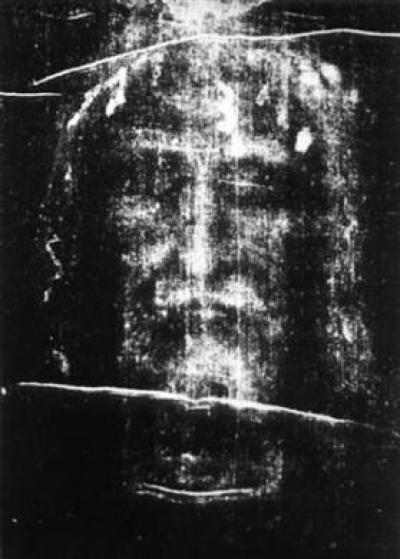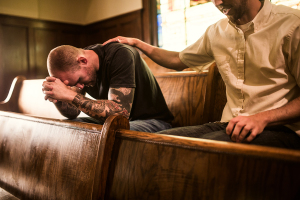Shroud of Turin: Suffering, sacrifice point to the victory of Easter

The Shroud of Turin is the first viral image.
The ghostly, haunting image of the crucified man on the Shroud has shaped how we depict Jesus still today. This famous linen cloth became part of the historical record in the 14th century when it was viewed by throngs of pilgrims.
It became an object of intense interest and devotion in 1578 when it was brought to Turin, Italy, so that Saint Charles Borromeo could pray before it in thanksgiving for the city of Milan being spared the ravages of the plague. Copies were made of the Shroud and pressed against it, to be displayed and reverenced in churches and cathedrals around Europe.
In May of 1898, amateur photographer Secondo Pia took the first photographs of the Shroud. His photo negative glass plates revealed for the first-time details of the face, images still used devotionally in the Roman Catholic tradition as part of the devotion of the Holy Face of Jesus. The image of the man of the Shroud has been on the cover of national news magazines and the subject of television documentaries. Very little peer-reviewed scientific study has been dedicated to the Shroud, though the results point to a late medieval date of origin.
But whether authentic or pious copy, the image of the Shroud of Turin is the most familiar and well-known image of any figure from the Bible.
Yet it is not a beautiful image, or appealing, or artistically pleasing. The Shroud of Turin carries the image of a man who was crucified.
The crucified man wears no saintly halo in the Shroud. On his head is a crown made of thorns, with blood from the piercing wounds staining the cloth (Matthew 27:29). The body is scarred by the bloody marks of the whip. Bloodstains mark the places where nails would have driven to fasten him to a wooden cross (John 20:25). His side has stains from both blood and a clear substance (John 19:34).
The man of the Shroud suffered. He was crucified, dead and buried. Just as Jesus was.
I write these words from the Old City of Jerusalem, just before Holy Week and steps away from the Church of the Holy Sepulchre, Golgotha, and further away, Gethsemane. For centuries pilgrims have journeyed to these traditional sites marking where Jesus of Nazareth suffered, died, and was buried. With the easing of COVID restrictions, pilgrims are again returning to these places to reflect on the suffering of Jesus. Though the exact locations of these sites are sometimes debated, the suffering and crucifixion of Jesus are not. People are still drawn to the places and the image of the man who was crucified.
“Mystery and Faith: The Shroud of Turin” recently opened as a special exhibition at Museum of the Bible in Washington, D.C. The interactive and technology-rich experience focuses on this famous image and the devotion, veneration, and history of the Shroud and its image of a crucified man. The responses from guests as they leave the gallery center not on the Shroud but on the man of the Shroud, the one who endured such pain and suffering before being put to death.
Pope Benedict XVI called the Shroud of Turin “the Icon of Holy Saturday.” Holy Saturday in the Bible and in classical Christian teaching is the day when God is silent, even dishearteningly silent. In the New Testament gospels, Friday, the day of crucifixion, is when God responds to Jesus’ death with earthquakes and darkness. The following Sunday is the day of resurrection and new life. But on Saturday, while Jesus lay dead in the tomb, nothing happened. God was silent.
Springtime of 2022 is a time when God seems to be silent again. We are in a suspended time, a time when it seems the direction of our future could turn suddenly much worse, or suddenly much better. Wars in Ukraine, Syria, Yemen, Libya, and scores of other places could suddenly become much more destructive, or peace could be declared. We do not yet know. We are suspended between pandemic and normalcy, racial divisions and harmony, economic stagnation and prosperity. Which will be our future? We do not yet know. We are tired, on edge, and expectant — waiting to see what will happen but incapable of effecting a positive way forward.
In the Gospels, God answers His silence of Saturday with new life. “Don’t be alarmed,” says the young man dressed in white to the women who come to Jesus’ tomb expecting to find a dead body. “You are looking for Jesus the Nazarene, who was crucified. He has risen! He is not here. See the place where they laid him” (Mark 16:6).
The Shroud of Turin, with its bloodstains and signs of torture, reminds us that the victory of Easter Sunday was possible only because of the suffering and sacrifice of Friday.
We would rather not look upon suffering. We are rightly outraged when people cause others to suffer. Even less would we ask to suffer ourselves or sacrifice for others. Yet it is through individuals putting the needs of others before their own that comes victory. Even in our time of turmoil, countless nurses, doctors, teachers, and childcare providers have put themselves at risk and sacrificed their time and comfort to care for others. In Ukraine, individuals have placed themselves at deadly risk to defend their homes and families.
In the New Testament, Jesus is the ultimate example of suffering that leads to victory. Of sacrificing oneself for the good of others. Even for those who do not ask for it. In a world of seeking our own good and individual striving even at the expense of others, the example of Jesus reminds us again that “Greater love has no one than this: to lay down one’s life for one’s friends” (John 15:13).
Jeffrey Kloha is Chief Curatorial Officer at Museum of the Bible.



























